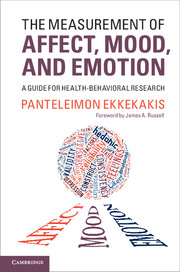Book contents
- Frontmatter
- Contents
- Figures
- Foreword
- Prologue
- 1 Documenting the breadth and depth of the problem
- 2 Untangling the terminological Gordian knot
- 3 Should affective states be considered as distinct entities or as positioned along dimensions?
- 4 Are pleasant and unpleasant states independent or polar opposites?
- 5 Selecting a measure
- 6 The old classics
- 7 Dimensional measures
- 8 Domain-specific measurement
- 9 Problems of domain specificity
- Epilogue
- References
- Index
- References
References
Published online by Cambridge University Press: 05 March 2013
- Frontmatter
- Contents
- Figures
- Foreword
- Prologue
- 1 Documenting the breadth and depth of the problem
- 2 Untangling the terminological Gordian knot
- 3 Should affective states be considered as distinct entities or as positioned along dimensions?
- 4 Are pleasant and unpleasant states independent or polar opposites?
- 5 Selecting a measure
- 6 The old classics
- 7 Dimensional measures
- 8 Domain-specific measurement
- 9 Problems of domain specificity
- Epilogue
- References
- Index
- References
- Type
- Chapter
- Information
- The Measurement of Affect, Mood, and EmotionA Guide for Health-Behavioral Research, pp. 173 - 203Publisher: Cambridge University PressPrint publication year: 2013



